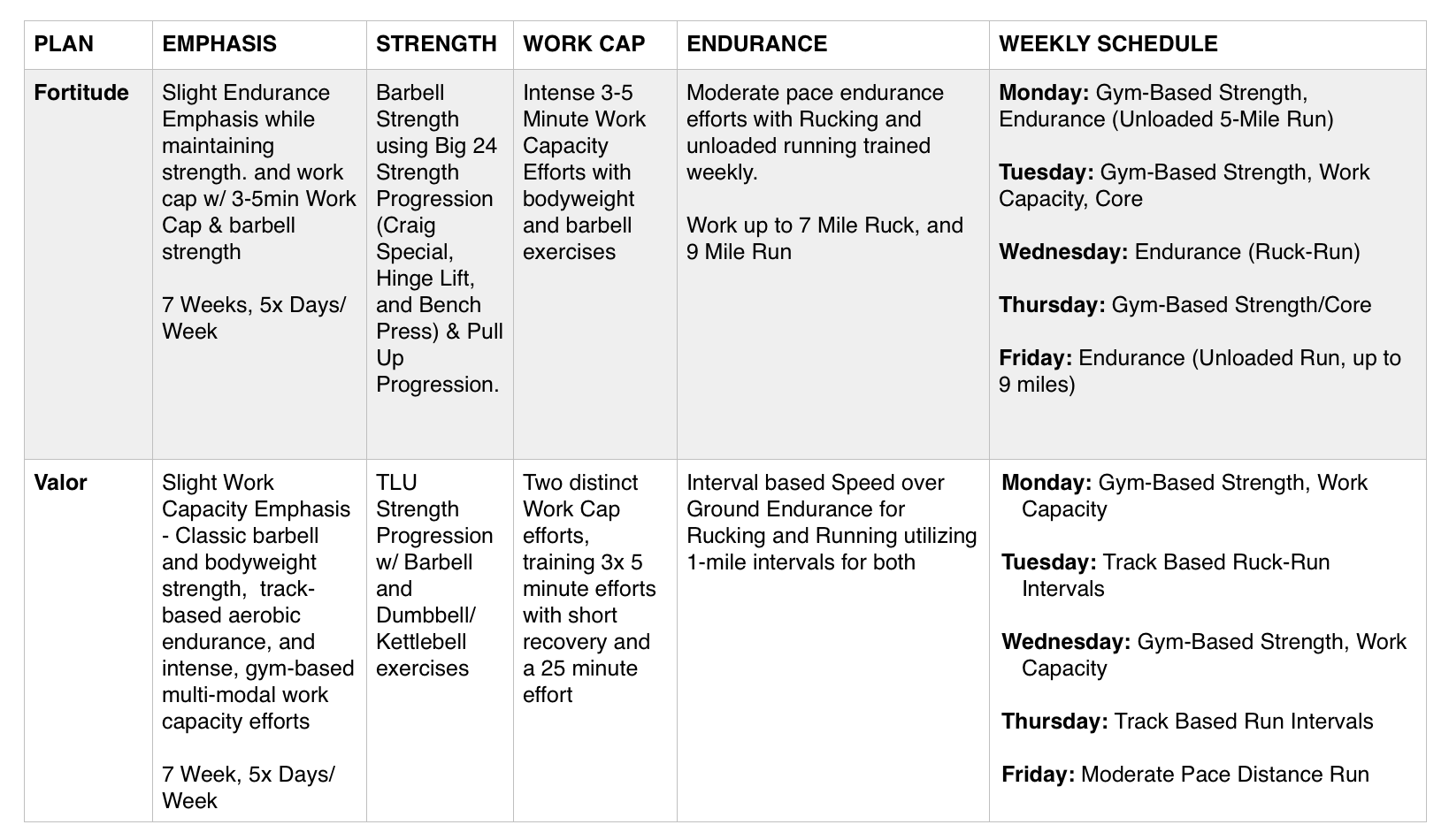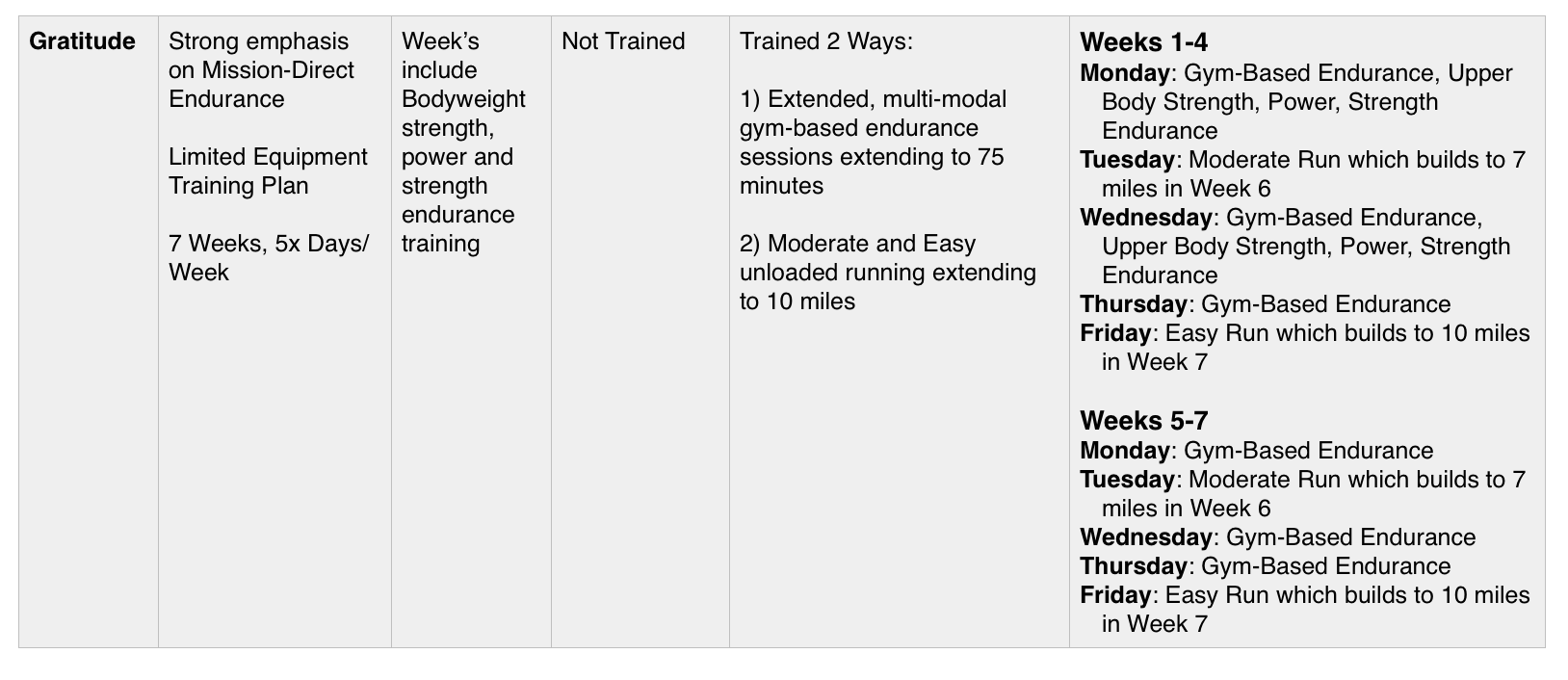By Rob Shaul
The primary challenge in programming for Tactical Athletes is design which works to improve all of the fitness demands they face. Each plan in the Virtue Packet concurrently trains each of these attributes:
- Relative Strength
- Work Capacity
- Endurance
- Durability
- Chassis Integrity
The Military On Ramp Training Plan establishes base fitness for the follow-on plans.
Humility
Humility, the first plan in the series, is a “balanced plan” and trains all five attributes in a balanced manner. Humility also gets back to fitness fundamentals.
“Humility” is so named because it’s bodyweight and limited equipment-focused. No fancy equipment, or cool-looking, austere, dungeon-esque functional-fitness gym is required.
The plan deploys a bodyweight strength and work capacity assessment, as well as a running assessment. Running is both unloaded, and loaded in your vest or IBA. It has a strong, multi-modal component – strength, work capacity and endurance.
Sometimes we all get a little fancy in our training, at our jobs, and in thinking about ourselves and how good we are or what we think we deserve. Humility is a good antidote for this dead-end, entitled thinking.
“Humility also has a “hardening” effect on the athletes who complete it – both physical and mental. It lays the groundwork for the remaining Virtue plans.”
This plan was updated in March, 2017.
The following plans – Fortitude, Valor, Resilience and Gratitude – train each fitness attribute, but each plan has a distinguishable emphasis on one or two of them.
Fortitude
Fortitude’s emphasis is strength and endurance. When first designed in 2014, Fortitude plan marked a significant shift in my programming approach – both on the military and mountain side. I’d come to suspect – and working through Fortitude confirmed, that we had a “hole” in our programming on the endurance side.
Endurance is tricky from a programming perspective. Done the typical method, there is little time for anything else. As well – not only is endurance cardio-focused and mode-specific, but there is a “endurance” element for joints and connective tissue as well.
“With Fortitude, I was able to bridge the gap between pure endurance work, time constraints, and maintaining strength and work capacity.”
Ultimately I programmed high intensity (load), low volume (reps) barbell-based strength training, with volume-based, moderate pace endurance (running and ruck running). In the training week, we were also able to find room for work capacity and focused chassis Integrity work. I updated Fortitude to reflect my most recent programming evolution in March, 2017.
Valor
Valor’s emphasis is work capacity.
When it comes to work capacity, the demands for Military Athletes can be of multiple durations. We know the average football play lasts around 40 seconds, and likely never more than 1:30. But a firefight is not as defined. This is the reason our work capacity programming focuses on varying durations.
We purposely design work capacity events ranging from 2 to 30 minutes long. To be efficient, in Valor our gym-based sessions are hybrid – they train both strength (first) and work capacity (second). Monday’s work capacity efforts are longer, 15-30 minutes which include a single mode endurance activity like running, or step ups, and Wednesdays are shorter – three, 5-minute hard, short and simple, multi-modal efforts – barbell work and burpees.
Valor doesn’t ignore strength or endurance. On the endurance side, with Valor, we transition from the long, slow, endurance work in Fortitude to hard, intense, fast and short, running and ruck running intervals.
Valor was updated in March, 2017.
Resilience
The focus of Resilience is “Chassis Integrity.”
Since the beginning, our tactical programming has concentrated on the “combat chassis” – legs, core, lungs – the “engine” of tactical performance. We’ve deployed lower, upper, core and total body strength exercises to build a strong “chassis.”
However, outside the gym, a tactical athlete’s body moves and lifts as an integrated system. Never do his different body areas lift, move and load carry in isolation.
How could we better train the “integrity” of the whole? Resilience is our answer. This plan was also updated in March, 2017.
Gratitude
Gratitude is is the fifth and last plan added to the “Virtue” series, and emphasizes endurance. This plan was built in March 2017 when we updated the other plans in the series.
In terms of strength and conditioning, “endurance training” generally refers to training single mode efforts – running, rucking, swimming, biking, etc.
“For the Mountain and Tactical Athletes we work with, we understand there is another kind of constant movement endurance which can be multi-modal, and is often loaded. Examples on the tactical side include long team events at military selections and line clearing for wildland firefighters. An example on the mountain side could be hours digging out tent placement locations on big mountain alpine climbs.”
Often these efforts have a significant demand on the “combat chassis” – the musculature between the knees and the shoulders, and Chassis Integrity.
We built our gym-based endurance programming around these demands … loaded, multi modal and with a significant chassis integrity emphasis.
In terms of strength and conditioning, “endurance training” generally refers to training single mode efforts – running, rucking, swimming, biking, etc.
The gym-based endurance events you’ll experience in Gratitude extend from 30 and 45 minutes in Week 1 to 60 and 75 minutes in Week 6.
In addition to gym-based endurance, Gratitude also trains single-mode endurance in the form of unloaded running.
Plan Overview
The Military On Ramp Training Plan establishes base fitness for the follow-on plans:


 Questions?
Questions?
Email coach@mtntactical.com

